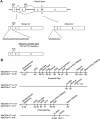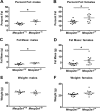MeCP2 isoform e1 mutant mice recapitulate motor and metabolic phenotypes of Rett syndrome
- PMID: 30137367
- PMCID: PMC6240741
- DOI: 10.1093/hmg/ddy301
MeCP2 isoform e1 mutant mice recapitulate motor and metabolic phenotypes of Rett syndrome
Abstract
Mutations in the X-linked gene MECP2 cause the majority of Rett syndrome (RTT) cases. Two differentially spliced isoforms of exons 1 and 2 (MeCP2-e1 and MeCP2-e2) contribute to the diverse functions of MeCP2, but only mutations in exon 1, not exon 2, are observed in RTT. We previously described an isoform-specific MeCP2-e1-deficient male mouse model of a human RTT mutation that lacks MeCP2-e1 while preserving expression of MeCP2-e2. However, RTT patients are heterozygous females that exhibit delayed and progressive symptom onset beginning in late infancy, including neurologic as well as metabolic, immune, respiratory and gastrointestinal phenotypes. Consequently, we conducted a longitudinal assessment of symptom development in MeCP2-e1 mutant females and males. A delayed and progressive onset of motor impairments was observed in both female and male MeCP2-e1 mutant mice, including hind limb clasping and motor deficits in gait and balance. Because these motor impairments were significantly impacted by age-dependent increases in body weight, we also investigated metabolic phenotypes at an early stage of disease progression. Both male and female MeCP2-e1 mutants exhibited significantly increased body fat compared to sex-matched wild-type littermates prior to weight differences. Mecp2e1-/y males exhibited significant metabolic phenotypes of hypoactivity, decreased energy expenditure, increased respiratory exchange ratio, but decreased food intake compared to wild-type. Untargeted analysis of lipid metabolites demonstrated a distinguishable profile in MeCP2-e1 female mutant liver characterized by increased triglycerides. Together, these results demonstrate that MeCP2-e1 mutation in mice of both sexes recapitulates early and progressive metabolic and motor phenotypes of human RTT.
Figures









Similar articles
-
Mice with an isoform-ablating Mecp2 exon 1 mutation recapitulate the neurologic deficits of Rett syndrome.Hum Mol Genet. 2014 May 1;23(9):2447-58. doi: 10.1093/hmg/ddt640. Epub 2013 Dec 18. Hum Mol Genet. 2014. PMID: 24352790 Free PMC article.
-
Mutations in MECP2 exon 1 in classical Rett patients disrupt MECP2_e1 transcription, but not transcription of MECP2_e2.Am J Med Genet B Neuropsychiatr Genet. 2012 Mar;159B(2):210-6. doi: 10.1002/ajmg.b.32015. Epub 2011 Dec 27. Am J Med Genet B Neuropsychiatr Genet. 2012. PMID: 22213695
-
Novel exon 1 mutations in MECP2 implicate isoform MeCP2_e1 in classical Rett syndrome.Am J Med Genet A. 2009 May;149A(5):1019-23. doi: 10.1002/ajmg.a.32776. Am J Med Genet A. 2009. PMID: 19365833
-
Regulation, diversity and function of MECP2 exon and 3'UTR isoforms.Hum Mol Genet. 2020 Sep 30;29(R1):R89-R99. doi: 10.1093/hmg/ddaa154. Hum Mol Genet. 2020. PMID: 32681172 Free PMC article. Review.
-
Sex differences in Mecp2-mutant Rett syndrome model mice and the impact of cellular mosaicism in phenotype development.Brain Res. 2020 Feb 15;1729:146644. doi: 10.1016/j.brainres.2019.146644. Epub 2020 Jan 2. Brain Res. 2020. PMID: 31904347 Free PMC article. Review.
Cited by
-
Sphingolipid Metabolism Perturbations in Rett Syndrome.Metabolites. 2019 Oct 10;9(10):221. doi: 10.3390/metabo9100221. Metabolites. 2019. PMID: 31658741 Free PMC article.
-
Steatotic liver disease diagnosed in a 24-year-old woman with Rett syndrome: a case report.J Int Med Res. 2025 Jan;53(1):3000605241310158. doi: 10.1177/03000605241310158. J Int Med Res. 2025. PMID: 39804933 Free PMC article.
-
Exploring the complexity of MECP2 function in Rett syndrome.Nat Rev Neurosci. 2025 Jul;26(7):379-398. doi: 10.1038/s41583-025-00926-1. Epub 2025 May 13. Nat Rev Neurosci. 2025. PMID: 40360671 Review.
-
Proteomic and transcriptional changes associated with MeCP2 dysfunction reveal nodes for therapeutic intervention in Rett syndrome.Neurochem Int. 2021 Sep;148:105076. doi: 10.1016/j.neuint.2021.105076. Epub 2021 May 26. Neurochem Int. 2021. PMID: 34048843 Free PMC article. Review.
-
The Molecular Functions of MeCP2 in Rett Syndrome Pathology.Front Genet. 2021 Apr 23;12:624290. doi: 10.3389/fgene.2021.624290. eCollection 2021. Front Genet. 2021. PMID: 33968128 Free PMC article. Review.
References
-
- Mnatzakanian G.N., Lohi H., Munteanu I., Alfred S.E., Yamada T., MacLeod P.J.M., Jones J.R., Scherer S.W., Schanen N.C., Friez M.J. et al. (2004) A previously unidentified MECP2 open reading frame defines a new protein isoform relevant to Rett syndrome. Nat. Genet., 36, 339–341. - PubMed
-
- Gianakopoulos P.J., Zhang Y., Pencea N., Orlic-Milacic M., Mittal K., Windpassinger C., White S.J., Kroisel P.M., Chow E.W.C., Saunders C.J. et al. (2012) Mutations in MECP2 exon 1 in classical Rett patients disrupt MECP2_e1 transcription, but not transcription of MECP2_e2. Am. J. Med. Genet. Part B Neuropsychiatr. Genet., 159B, 210–216. - PubMed
-
- Saunders C.J., Minassian B.E., Chow E.W.C., Zhao W. and Vincent J.B. (2009) Novel exon 1 mutations in MECP2 implicate isoform MeCP2-e1 in classical Rett syndrome. Am. J. Med. Genet. Part A, 149, 1019–1023. - PubMed
Publication types
MeSH terms
Substances
Grants and funding
LinkOut - more resources
Full Text Sources
Other Literature Sources
Medical
Molecular Biology Databases

